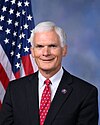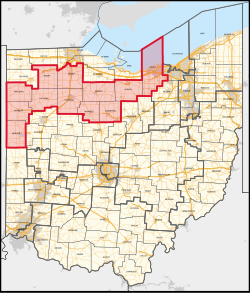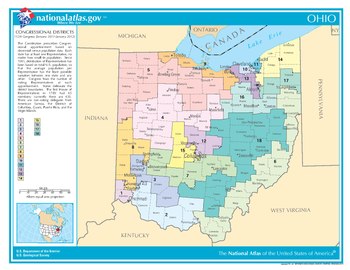


Ohio is divided into 15 congressional districts, each represented by a member of the United States House of Representatives. After the 2010 census, Ohio, which up until then had 18 districts, lost two House seats due to slow population growth compared to the national average,[1] and a new map was signed into law on September 26, 2011. Starting in the 2022 midterms, per the 2020 United States census, Ohio lost its 16th congressional seat, ending up with its current 15 districts.[2]
The following table is a list of members of the United States House delegation from Ohio, their terms, their district boundaries, and the district political ratings according to the CPVI. The delegation in the 118th United States Congress has a total of 15 members, with 10 Republicans and 5 Democrats.
| Current U.S. representatives from Ohio | |||||
|---|---|---|---|---|---|
| District | Member (Residence)[3] |
Party | Incumbent since | CPVI (2022)[4] |
District map |
| 1st |  Greg Landsman (Cincinnati) |
Democratic | January 3, 2023 | D+2 | 
|
| 2nd |  Brad Wenstrup (Hillsboro) |
Republican | January 3, 2013 | R+25 | 
|
| 3rd |  Joyce Beatty (Columbus) |
Democratic | January 3, 2013 | D+20 | 
|
| 4th |  Jim Jordan (Urbana) |
Republican | January 3, 2007 | R+20 | 
|
| 5th |  Bob Latta (Bowling Green) |
Republican | December 11, 2007 | R+15 | 
|
| 6th |  Michael Rulli (Salem) |
Republican | June 11, 2024 | R+16 | 
|
| 7th |  Max Miller (Rocky River) |
Republican | January 3, 2023 | R+7 | 
|
| 8th |  Warren Davidson (Troy) |
Republican | June 7, 2016 | R+14 | 
|
| 9th |  Marcy Kaptur (Toledo) |
Democratic | January 3, 1983 | R+3 | 
|
| 10th |  Mike Turner (Dayton) |
Republican | January 3, 2003 | R+4 | 
|
| 11th |  Shontel Brown (Warrensville Heights) |
Democratic | November 4, 2021 | D+28 | 
|
| 12th |  Troy Balderson (Zanesville) |
Republican | September 5, 2018 | R+18 | 
|
| 13th |  Emilia Sykes (Akron) |
Democratic | January 3, 2023 | R+1 | 
|
| 14th |  Dave Joyce (South Russell) |
Republican | January 3, 2013 | R+9 | 
|
| 15th |  Mike Carey (Columbus) |
Republican | November 4, 2021 | R+6 | 
|


On May 3, 2019, a three-judge panel from the United States District Court for the Southern District of Ohio declared Ohio's 2012 district map contrary to Article One of the United States Constitution, as "an unconstitutional partisan gerrymander" and ordered "the enactment of a constitutionally viable replacement" prior to the 2020 elections.[6] An appeal made to the U.S. Supreme Court resulted in the order to redraw the map being nullified.[7]
On November 17, 2021, after lengthy discussions, a new map was passed by the Ohio House of Representatives 55-36, along party lines, with no Democrat voting in favor of the map.[8] The map was sent to Governor of Ohio, Mike DeWine, where he accepted it 3 days later on November 20.[9]
The map has been controversial, as Democrats accuse the map of being purposefully designed to benefit Republicans.[8][9] By December 7, 2021, six lawsuits had been filed against the new 15-seat congressional map, citing it as "racially discriminatory". The proposed map favors Republican to Democratic districts by a 12-3 margin.[10]
On January 14, 2022, the Ohio Supreme Court declared the map a partisan gerrymander, violating Article XIX of the Constitution of Ohio, in a 4-3 decision. The Ohio General Assembly had 30 days to draw a new map.[11]
On March 16, 2022, the Ohio Supreme Court rejected the new proposed state legislative district map for the third time.[12] In spite of the decision, the primary elections scheduled to take place on May 3 were held using the second set of districts. Even though the maps were struck down, the state’s constitution allows for the second version to be used for the primary elections because a third proposal won’t be ready until after the May 3 primary.[13][14]
|
| |
|---|---|
|